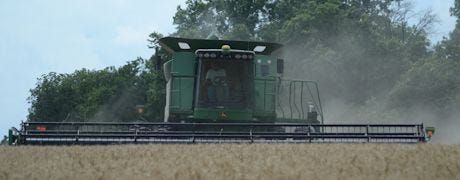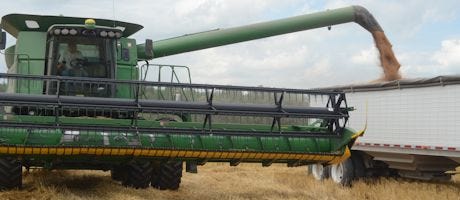
Wheat harvest is well underway for farmers in Missouri. As of June 29, 49% of the Missouri wheat crop was harvested – 2 percentage points ahead of last year, but 22 percentage points behind the 5-year average, according to USDA National Agriculture Statistics Service's weekly crop progress and condition report. Winter wheat condition was rated 49% good to excellent.

ROLLER COASTER WEATHER: Dennis Isgrig harvesting wheat last week in Audrain County. This spring's roller coaster temperatures, going from cold, to hot, to cold again, caused some concern from some farmers. "I don't remember another year it was cold for a week, then warm for a week, and cold for another week," Isgrig says. "It kept doing that each month."
April and May both saw roller coaster temperatures in Missouri, according to the Missouri Climate Center reports, with temperatures dropping below freezing in some places in the mid-April, and into the mid-30s in mid-May – when some locations reported frost damage. This was a direct contrast with early May, when some parts of southwest Missouri saw temperatures in the 90s for a couple days.
"I don't remember another year it was cold for a week, then warm for a week, and cold for another week. It kept doing that each month," says Dennis Isgrig, whose family farms 3,400 acres in Audrain and Callaway Counties. "But, there is always a different challenge each year."
The crop condition has been largely dependent on how the wheat weathered the cold temperatures this spring, Isgrig adds. "Some of the wheat just died and turned brown when it warmed up this spring," he says. "A lot of people worked it under."

NEXT PLATEAU: Despite this year's ups and downs in the weather, Dennis Isgrig's wheat crop gained a boost from being planted earlier in the first half of October, reaching over 70 bushels per acre in some fields. "Upper 60s and 70s is what we've been getting for a yield average lately," he says. "And now we're trying to shoot higher."
The next plateau
After planting earlier in the first half of October, Isgrig says most of his crop was able to put on some size before winter. This spring's ups and downs include some rain at the flag leaf stage, bringing disease pressure. To counter this and reach higher yield potential, Isgrig applied fungicide on a couple fields for the first time this year. "We've been raising 70-bushel wheat without applying fungicide, but we're working on getting to the next plateau."
On some fields, the yield monitor in the John Deere 9670 STS combine read an average of 72 bushels per acre, with 14.5% average moisture, and an average test weight of 57 pounds. "Upper 60s and 70s is what we've been getting for a yield average lately," he says. "And now we're trying to shoot higher."
Missouri's wheat acres have steadily declined in the last 20 years, with about one million acres harvested in 2013, according to NASS. According to NASS, Audrain County ranks 8th in the state for total winter wheat acres, as of 2008.
Of course, Missouri is soybean country, and many wheat farmers, like Isgrig, double crop soybeans after winter wheat. During years like this, when many are harvesting wheat later than usual, there is less time to plant beans. "If we aren't baling straw, we're usually in the field planting the same time we're combining," he says. "The longer it takes to get the soybeans established, the less growing days they have. The sooner you get the beans in, the better chance of having a higher yield."
About the Author(s)
You May Also Like






